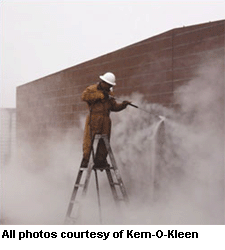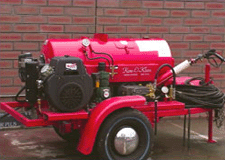Systemizing the Cleaning Process
By Ron Baer
 Despite changes over the years, one fact of masonry business remains true: the last step in the masonry building process ? the one that takes so little time and is generally left to the least skilled laborer ? is the one that gives the overall impression of your work. If the job is cleaned properly, then it is usually seen as a good job. On the flip side of the coin, the reverse can hold true as well.
Despite changes over the years, one fact of masonry business remains true: the last step in the masonry building process ? the one that takes so little time and is generally left to the least skilled laborer ? is the one that gives the overall impression of your work. If the job is cleaned properly, then it is usually seen as a good job. On the flip side of the coin, the reverse can hold true as well.
Are masonry contractors making the same mistake as many other businesses that rely on relatively low-paid individuals to make the first and last impressions on customers? Banks do it all the time, leaving customer contact to tellers whose typical longevity is measured in months, not years. Large companies do it with telephone operators and receptionists also.
A simple solution to this issue ? put a mason on the job ? would only yield more problems. Our experienced masons don't want to clean, plus we need to get them on to the next job.
What's the answer to the dilemma? You can either do the job yourself or turn to the same answer that managers use when they want to be assured that an employee is doing the things we want them to be doing, when we want them to be doing it, and the way we want them to be doing it: systemize and mechanize the operation.
Step 1: Choose the Equipment
To systemize cleaning there are two choices in equipment. One choice in equipment can be a general purpose, high pressure washers, such as those manufactured by Landa, Hotsy, Mighty M and the European company, Karcher.
A second alternative is to use a washer made specifically for cleaning masonry such as those available from Kem-O-Kleen. Though they're also able to serve as a standard washer, Kem-O-Kleen machines are specifically made for cleaning new masonry and restoring older masonry.
For those who are looking for more information, MCAA's Masonry Showcase in Las Vegas, March 2004, will be a great opportunity to check out what's new in cleaning equipment.
Step 2: Choose the Chemical and Application Process
Chemical manufactures, such as Sure Kleen, Arrow and Diedrick, are constantly developing new chemicals to meet specific needs. Though most contractors have their favorite brand and type of chemical that they prefer, it is worthwhile to experiment and try new offerings from time to time.
Obviously, as every chemical is different, you should refer to the manufacturer for mixture amounts, time and procedures.
With general purpose standard washers, it is possible to apply some relatively inert cleaning chemicals such as liquid detergents at low pressure with water. Keep in mind that harsher cleaning chemicals will, over a short period of time, destroy many of the parts of a general purpose washer.
Standard pressure washers do enable systemization to some extent. All washers operate at near their rated pressure or less, eliminating the danger that an operator will use pressure in excess of the rate.
 When using a standard washer, the cleaning chemical can be applied in one of three general ways. First, it can be applied with the machine, using a chemical injector. A second application method is to apply the chemical with a separate hand pump. The third option is to brush on the chemical by hand.
When using a standard washer, the cleaning chemical can be applied in one of three general ways. First, it can be applied with the machine, using a chemical injector. A second application method is to apply the chemical with a separate hand pump. The third option is to brush on the chemical by hand.
Controlling the flow rate of the chemical is difficult to judge because the chemical must always be applied with water. Once the chemical has been applied the pressure can be returned to rinse the surface.
Kem-O-Kleen equipment has an adjustable chemical delivery system that enables the operator to apply the chemical in a variety of ways, depending on what works best for the particular type of surface being cleaned. Contractors should be familiar with these choices and have a systemized way for laborers to use the correct delivery method for each application.
Step 3: Choose a Nozzle Pattern
One variable that may be overlooked is the nozzle pattern. Most standard washers are supplied with a variety of nozzles, each having a different spray pattern, which are measured in degrees. A zero degree nozzle has a concentrated spray pattern, creating maximum pressure over a very small area. A 45 degree nozzle distributes the pressure of a wider area as the water leaves the nozzle in a spray that is 45 degrees wide.
A relatively new tool available for washing masonry is a nozzle that gives you the power of a zero degree nozzle but the water comes out of the nozzle in a conical pattern created by the pulsating and rotating nozzle. Sometimes referred to as a "turbo nozzle," it has features that make it very useful for cleaning harder brick types and block ? it should not be used on soft brick. Turbo nozzles are also useful when washing equipment and for other general cleaning chores.
Don't leave the choice of nozzles to the operator. Using certain nozzles may cause damage to the surface. Find the nozzle pattern that works and leave only that one with the machine.
Step 4: Test Panel
Once you have decided on what type of machine, chemical and nozzle to use, it is a good idea to test your systemized cleaning process on a test panel for approval by the architect. Since some color variation may occur as a result of cleaning, the test panel should display all of the specified brick, block and mortar types specified for the job with the cleaning process that you anticipate using for the entire job.
Some of your choices for each of these steps may change depending on the job at hand, but the process itself should be systemized from start to finish to assure that your company's hard work will leave a lasting positive impression.
About the Author
Ronald Baer is President of Unique Industries, Inc., manufacturer of Kem-O-Kleen masonry cleaning equipment, and Enterprise Consulting of Colorado, Inc., a consulting firm providing management services to family-owned businesses. He is also a facilitator for The Alternative Board (TAB). He may be reached at 800-274-4121.


















